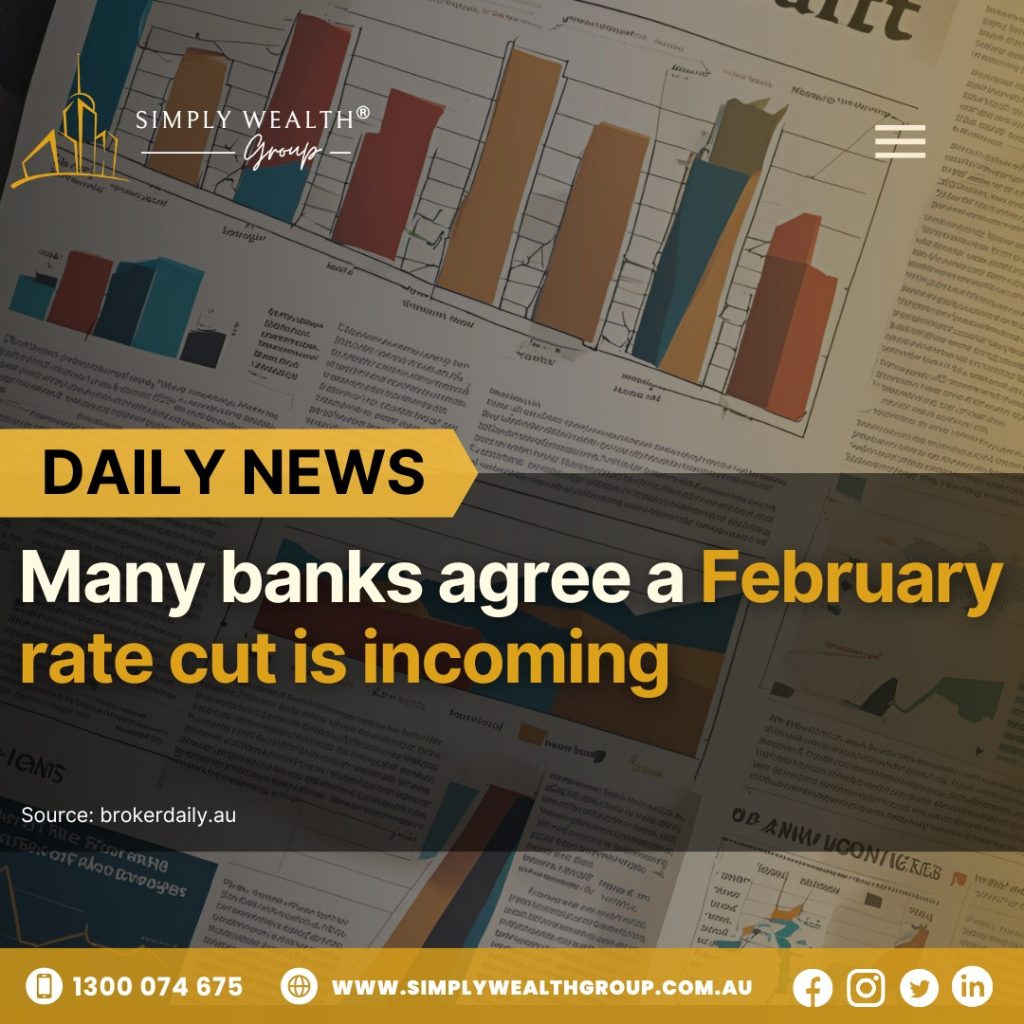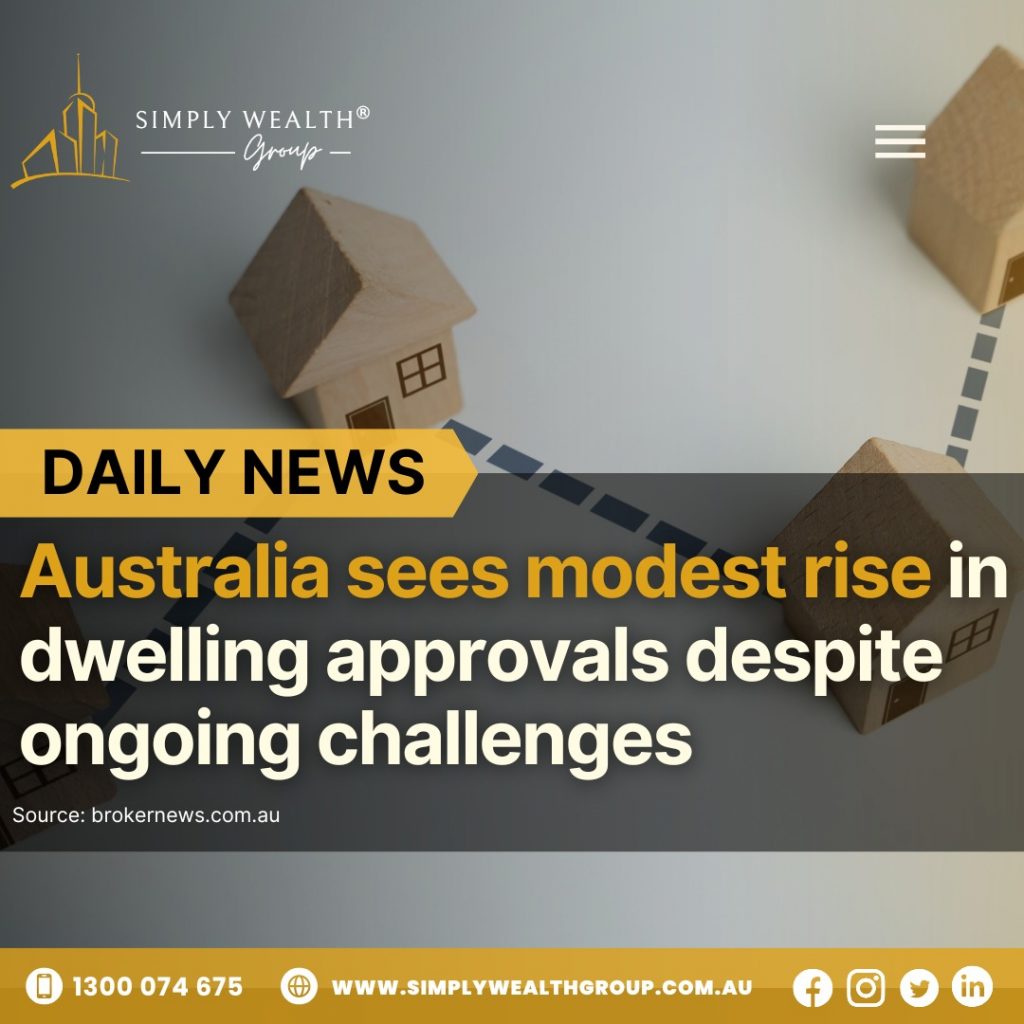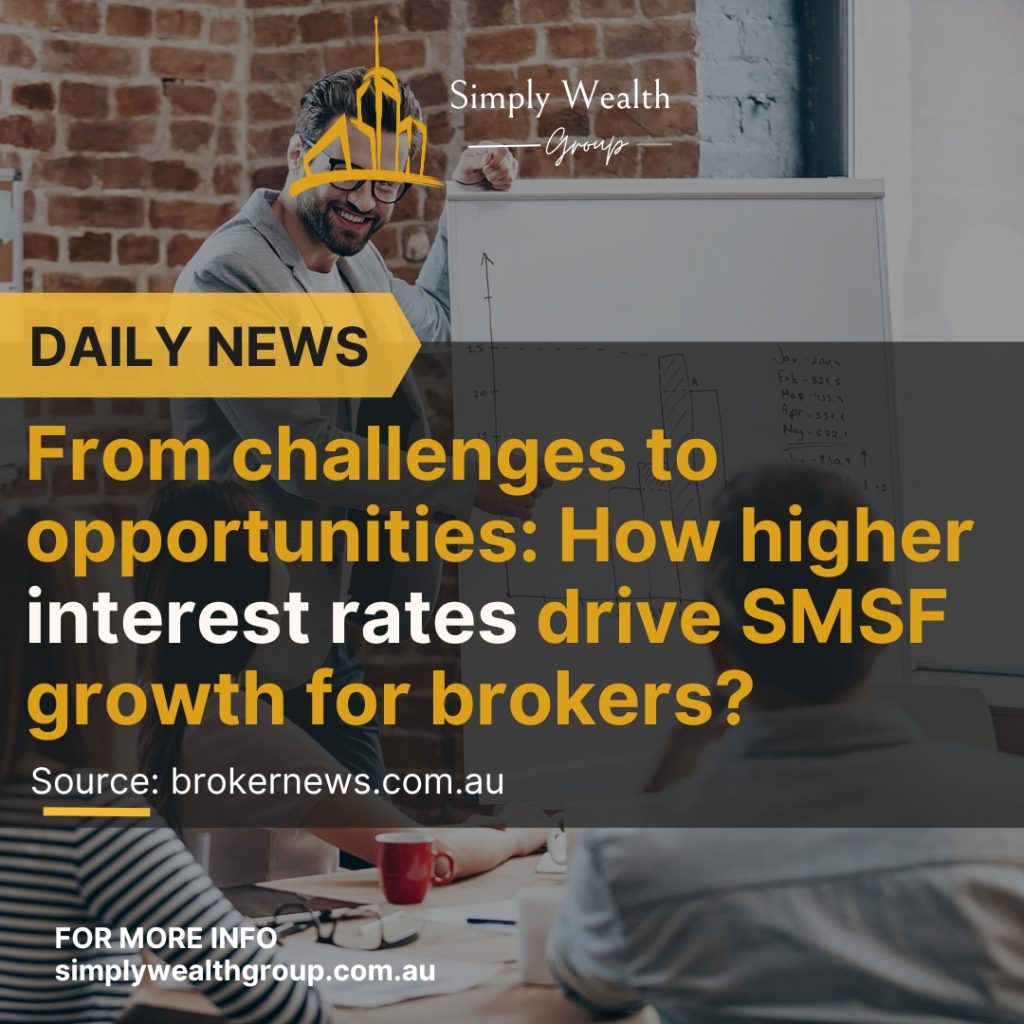Many Banks Agree: A February Rate Cut Is Incoming!

Many Banks Agree: A February Rate Cut Is Incoming! With inflation easing, several major banks predict the Reserve Bank of Australia (RBA) may announce a rate cut this February. This could bring much-needed relief to homeowners and investors, opening doors to better borrowing conditions and housing market growth. What Does This Mean for You? ✅ Lower Mortgage Costs – Reduced interest rates mean smaller repayments for homeowners.✅ Better Borrowing Power – Buyers can secure more competitive loans, making it easier to enter the market.✅ Boosted Market Confidence – A rate cut may drive increased property demand, pushing prices higher.✅ Increased Investment Opportunities – More affordable financing options can help investors expand their portfolios. Why Act Now? A rate cut could trigger a surge in property interest—making now a strategic time to buy, invest, or refinance before competition heats up. With property prices potentially rising in response to lower rates, securing a deal now could mean greater capital growth in the long run. 🏡 Thinking of buying your first home? Now may be the perfect time to step into the market with improved affordability.📈 Investors, are you ready? Leverage lower rates to maximize returns on your next property venture. 🔗 Read more: https://tinyurl.com/476jw3ut SimplyWealth Group is here to guide you through the changing market. Let’s plan your next move! 📞 Call us today: 1300 074 675📩 Get expert insights & updates:🌐 Website: simplywealthgroup.com.au📌 Facebook: Simply Wealth Group📷 Instagram: @simply_wealth_group💼 LinkedIn: simply-wealth-group
Australia Sees Modest Rise in Dwelling Approvals Despite Ongoing Challenges

Australia Sees Modest Rise in Dwelling Approvals Despite Ongoing Challenges In December, the Australian housing market saw a slight rebound in the number of dwelling approvals, rising by 0.7% to 15,174, after a significant drop of 3.4% in November. This modest increase signals resilience in the sector, despite ongoing challenges such as rising construction costs, labor shortages, and fluctuating interest rates. Read more here: https://tinyurl.com/55evf7zb Why Does This Matter? ✅ Continued Market Confidence – Developers remain committed to new projects, indicating strong underlying demand. ✅ Potential for Supply Relief – Increased approvals could help ease housing shortages, particularly in high-demand areas. ✅ Investment Opportunities – More development activity means fresh opportunities for investors looking for long-term growth and capital appreciation. Looking Ahead While challenges such as higher building costs and economic uncertainty persist, this upward trend reflects the adaptability of the housing sector. The ongoing supply and demand imbalance continues to drive interest in new home builds, making now a crucial time for investors to act. With interest rate stability on the horizon, those who position themselves strategically can capitalize on market conditions before competition intensifies. At Simply Wealth Group, we specialize in helping Australians navigate the property market with expert insights and tailored strategies. Whether you’re a first-home buyer or an investor, we’ll help you make informed decisions and secure high-growth opportunities. Let’s Plan Your Next Move! 📞 Call us today: 1300 074 675 📢 Stay updated with expert property insights! 🔹 Facebook: Simply Wealth Group 🔹 Instagram: @simply_wealth_group 🔹 Website: simplywealthgroup.com.au 🔹 LinkedIn: Simply Wealth Group
📉 Rate Cuts in February May Boost the Australian Housing Market!

Rate Cuts in February May Boost the Australian Housing Market! According to recent data from the Australian Bureau of Statistics (ABS), inflation rates have fallen, leading experts to predict a high likelihood of interest rate cuts starting in February, SQM Research analysis showed. Read more here: https://tinyurl.com/y9h3664b What does this mean for you? Lower Mortgage Costs – Reduced interest rates mean lower monthly repayments. Increased Borrowing Power – Secure better loan terms and affordability. Market Growth Potential – Demand for property may rise, pushing values higher. A Golden Opportunity for Investors & HomebuyersWith market conditions shifting, strategic investments can lead to strong long-term gains. At SimplyWealth Group, we help you navigate changing market conditions to maximize your investment success. Let’s plan your next move! Call us now: 1300 074 675 Follow us for expert insights, market updates, and property tips:Facebook: Simply Wealth GroupInstagram: @simply_wealth_groupWebsite: simplywealthgroup.com.auLinkedIn: simply-wealth-group
Cost of Living Australia 2024: Cracking the Code on Future Expenses and Economic Trends

Cost of Living Australia 2024: Cracking the Code on Future Expenses and Economic Trends Wondering what the cost of living in Australia will be in 2024? Look no further. In this article, we’ll be cracking the code and forecasting the expenses you can expect in the year ahead. Whether you’re a current resident or planning to move Down Under, staying informed about the cost of living is essential for budgeting and financial planning. With the ever-changing economic landscape, it’s crucial to anticipate how inflation, housing prices, healthcare, education, and other factors will impact your wallet. Our comprehensive analysis of market trends and expert predictions will shed light on what to expect in terms of purchasing power, salary expectations, and necessary adjustments to your budget. We’ll also explore the impact of government policies, market fluctuations, and global influences on Australia’s cost of living. By understanding these factors, you can adapt and make informed decisions that will enable you to maintain a comfortable lifestyle in the years to come. Stay tuned as we dive deep into the numbers, debunk myths, and unveil insightful forecasts for the cost of living in Australia in 2024. Factors Influencing the Cost of Living in Australia The cost of living in Australia is a multifaceted issue influenced by various economic, social, and environmental factors. Understanding these influences is essential for predicting future expenses. One of the primary drivers is inflation, which reflects the general increase in prices and can erode purchasing power. In Australia, inflation rates have fluctuated, often responding to global economic conditions, local demand, and government policies. As prices rise, the cost of basic goods and services can become a significant burden on households, necessitating careful financial planning. Another critical factor is housing affordability. Australia has experienced a housing boom over the past few decades, leading to soaring property prices in major cities like Sydney and Melbourne. The demand for rental properties has also increased, pushing up rental costs. This trend often forces individuals and families to allocate a larger portion of their income to housing, impacting their overall budget. As the population continues to grow and urban centers attract more residents, understanding how housing will evolve in the coming years is vital. Lastly, government policies play a crucial role in shaping the cost of living. Changes in taxation, welfare programs, and housing regulations can directly impact disposable income. For instance, initiatives aimed at increasing affordable housing or improving public transport can ease living costs for many Australians. Conversely, austerity measures or tax increases may tighten budgets and require households to reevaluate their spending habits. By keeping an eye on these factors, individuals can better prepare for the financial landscape in Australia. Current Cost of Living in Australia As of 2023, the cost of living in Australia varies significantly between urban and rural areas. Major cities like Sydney, Melbourne, and Brisbane are known for their high living expenses, encompassing housing, transportation, and general consumer goods. According to the latest reports, Sydney has consistently ranked among the most expensive cities globally, with rental prices often exceeding AUD 3,000 per month for a two-bedroom apartment in the city center. In contrast, regional areas tend to offer more affordable housing options, making them attractive for families and retirees. Daily expenses, such as groceries and dining out, have also seen substantial increases. The typical Australian family spends around AUD 150 to AUD 250 per week on groceries, depending on dietary preferences and family size. Restaurants and cafes have also raised their prices, with a standard meal costing around AUD 20 to AUD 30. This steady rise in everyday expenses highlights the need for families to budget effectively and seek out cost-saving opportunities wherever possible. Transportation costs, including public transport fares and fuel prices, also contribute to the overall cost of living. Public transport in major cities can range from AUD 4 to AUD 10 per trip, and fuel prices have remained volatile, sometimes exceeding AUD 1.50 per liter. The cumulative effect of these expenses creates financial pressure on households, making it essential for residents to stay informed about market trends and adjust their financial strategies accordingly. Economic Forecast for Australia in 2024 Looking ahead to 2024, the Australian economy is expected to experience moderate growth, driven by both domestic and global factors. Economic indicators suggest that GDP growth may stabilize around 2.5% to 3%, a figure that reflects a recovery from the effects of the COVID-19 pandemic and the recent global economic turmoil. The resilience of the Australian economy is attributed to strong commodity exports, particularly in mining and agriculture, which continue to thrive on international demand. However, inflation remains a concern. Forecasts indicate that inflation rates could hover between 3% to 4%, primarily due to ongoing supply chain disruptions and rising energy costs. This inflation could further strain household budgets, necessitating adjustments in spending patterns. To combat this, consumers may need to prioritize essential goods and services while seeking out more cost-effective alternatives for non-essentials. Additionally, the labor market is anticipated to remain robust, with unemployment rates expected to stay low. This employment stability should provide a degree of financial security for many Australians, allowing for increased consumer spending. However, wage growth is not projected to keep pace with inflation, which could lead to a decline in real purchasing power. As such, individuals should remain vigilant and proactive in managing their finances to navigate the economic landscape effectively. Projected Changes in Housing Costs Housing costs in Australia have been a significant concern for many residents, and projections for 2024 indicate a continuation of this trend. The Australian property market has been characterized by rising prices, particularly in metropolitan areas. Experts predict that while housing prices may stabilize somewhat, they are unlikely to decline significantly. Factors such as low interest rates, high demand, and limited housing supply will continue to support property values. In urban centers, the demand for rental properties is expected to remain high, pushing rental prices further upwards. Approximately 30% of Australians are renters, and
From challenges to opportunities: How higher interest rates drive SMSF growth for brokers?

From challenges to opportunities: How higher interest rates drive SMSF growth for brokers? A higher interest rate environment and a desire for more financial control over retirement is driving SMSF lending growth, which is proving to be a boon for both brokers and lenders. Australian Taxation Office (ATO) data shows that in June 2024, there were a total of 625,609 SMSFs in Australia, an increase from 563,474 five years earlier in June 2019. With a total of over 1.1 million members, the total allocation of assets to residential property in Australian SMSFs is now over $55 billion, an increase from $36.5 billion back in 2019. For More Investment Consultation Please Contact Us At: Simply Invest Group Financial controllers According to Thinktank, more Australians are trying to get more control over their own wealth management during a period when super returns may not have met their expectations. SMSF investments into commercial properties are also growing; Thinktank said this is being driven by Limited Recourse Borrowing Arrangements (LBRAs), which allow an associated party— like a member’s own business—to lease the commercial property at market rent. S&P Global Ratings noted in its Australian RMBS and the Growing SMSF Factor report this year that SMSFs were becoming a more prominent feature of Australian RMBS transactions. Read Full Article At: Broker News For More Information on SMSF Please Contact Us: Simply Wealth Group
NAB cuts fixed rates official interest rates decrease next year

NAB Cuts Fixed Rates as Official Interest Rates Set to Decrease Next Year Big four bank NAB has cut its fixed rates for customers by up to 0.65 percentage points, as lenders anticipate a cash rate cut next year. The bank has chopped its owner-occupier principal and fixed interest rates by up to 0.5 percentage points, and investor and owner-occupier interest-only fixed rates by up to 0.65 percentage points, according to rate tracking by Canstar. It follows Macquarie Bank’s move last week to slash a range of fixed rates by up to 0.4 percentage points to 5.39 per cent — and could be a sign more rate cuts are to come. Homeowners are anxiously awaiting the Reserve Bank of Australia (RBA) to drop interest rates from the 13-year high of 4.35 per cent. Central banks in the United States, Canada and New Zealand are among those that have reduced interest rates, but the RBA maintains Australia is in a different boat. The minutes from its September meeting confirmed there was no explicit discussion of the case to hike interest rates. Read our blog on: Interest Rates ANZ head of Australian economics Adam Boyton said the minutes represented a “clear step down in the RBA board’s hawkishness”. “This leaves the door open to a shift to neutral by the end of this year and then easing in early 2025,” he said. NAB’s owner-occupied loans have fallen between 0.55 and 0.1 percentage points. The most significant change was for the bank’s two-year fixed loan, which dropped from 6.59 per cent to 6.04 per cent. The bank’s lowest three-year fixed rate of 5.89 per cent is now in line with Commonwealth Bank and Westpac, while ANZ’s offers above 6 per cent. More than 37 lenders have dropped at least one fixed rate over the last month, according to Canstar research. Australian Bureau of Statistics lending data shows just two per cent of new and refinanced loans in August opted for a fixed rate. Read Full Article at: 7 News Australia
Investor surge pushes Australian housing loans to two-year high

Investor surge pushes Australian housing loans to two-year high Australia’s housing market continued its upward trend in August 2024, reaching the highest level of new lending since May 2022. According to the latest data from the Australian Bureau of Statistics (ABS), the total value of new housing loans increased by 1.0% to $30.4 billion, with investor activity leading the charge. Canstar’s analysis of the ABS data showed that investor loans saw a significant boost, rising 1.4% in August to $11.71 billion – a 34.2% increase from the same period last year. This surge in investor lending marked the second-highest monthly value on record. Loans to owner-occupiers also grew, increasing by 0.7% to $18.7 billion, reflecting a 16.5% rise year-on-year. However, first-home buyers faced a slight dip, with loans for this group dropping by 1.5% from July to August. Despite the monthly decline, first-home buyer activity was still 9.2% higher than in August 2023. Tindall pointed out that while first-home buyers remain active, they face stiff competition from investors who can use rental income to offset the burden of higher mortgage payments. Breaking down the data by state, Queensland emerged as a key driver of the national rise. Housing loan commitments in the state soared by 40% over the past year, adding $2 billion in value, more than any other state. In contrast, the average national loan size for owner-occupiers dropped by 1% in August, falling to $636,208. Although most states saw decreases, Queensland and Tasmania bucked the trend, with Queensland posting a record high loan size of $603,988. Learn more about: Australia’s housing market
Fixed rates drop amidst predictions

Fixed rates drop amidst predictions Variable and fixed home loan rates saw both increases and cuts this week, with fixed rates outperforming variable, and a potential cash rate cut anticipated by February, Canstar reported. Home loan rate changes Aussie Home Loans raised interest rates on two variable owner-occupier and investor loans by 0.05%, while five other lenders reduced rates across 50 variable loans for both owner-occupiers and investors. Meanwhile, twelve lenders slashed fixed rates on 322 loans, with an average decrease of 0.24%. Fixed rates outperform variable options Abal Banking continues to offer the lowest variable rate at 5.75%, although a surge in rate cuts means that 112 fixed rates now sit below this, a significant increase from last week’s 64. “There was yet another downpour of fixed rate cuts this week,” said Sally Tindall (pictured above), Canstar’s data insights director. Major institutions like Bendigo Bank and Teachers Mutual Group are among those offering reduced rates. Read Full Article here at: Broker News
Advice for Young First Home Buyers

Unsurprisingly, one of the biggest hurdles for young people getting a mortgage is affordability. Melisa Sloan, founder of Madison Sloan Lawyers and author of Big Moments said that high demand and property shortages make things even tougher. “The biggest hurdle is affordability and obtaining finance in an environment where property prices, particularly in city areas are relatively high. Saving for a deposit and the ability to service a mortgage has increasingly become difficult for young people over the past two years, with many now reliant on parental or other family help to obtain a mortgage and get into the property market,” said Sloan. “Many people with good jobs and the ability to service a loan find themselves unable to obtain a mortgage because they do not have a sufficient deposit that is required by lenders. Additionally, property shortages continue to make it difficult for people for young people to get a mortgage.” You may read the whole article here:https://bit.ly/4d1mYQg
New Properties for Sale Up 1.3% – PopTrack

New listings in the housing market have increased year-on-year despite a seasonal slowdown, according to the latest PropTrack Listings Report. Compared to the previous month, June 2024 saw new listing volumes down 15%, marking the transition into a quieter season. Every capital city and regional area reported a monthly decrease in new listings in June. However, new listings were 1.3% higher compared to June 2023. Among capital cities, only Perth (-5.7%), Darwin (-6.7%), and Canberra (-2.6%) saw a year-on-year decline in new listings. In regional markets, only South Australia (+8.2%) experienced an increase in new listings over the year. You may read the whole article here:https://bit.ly/4bIZ8rt

